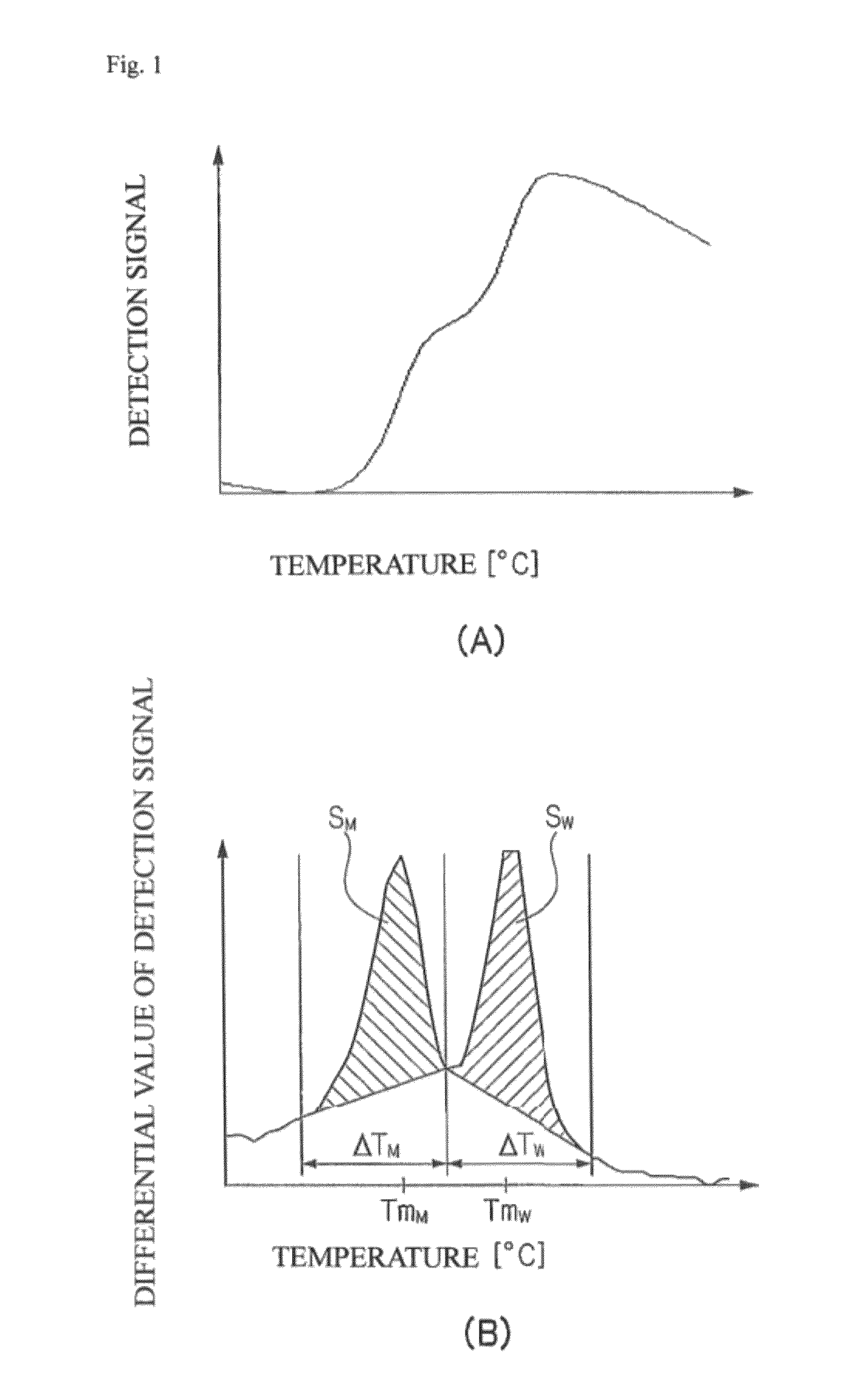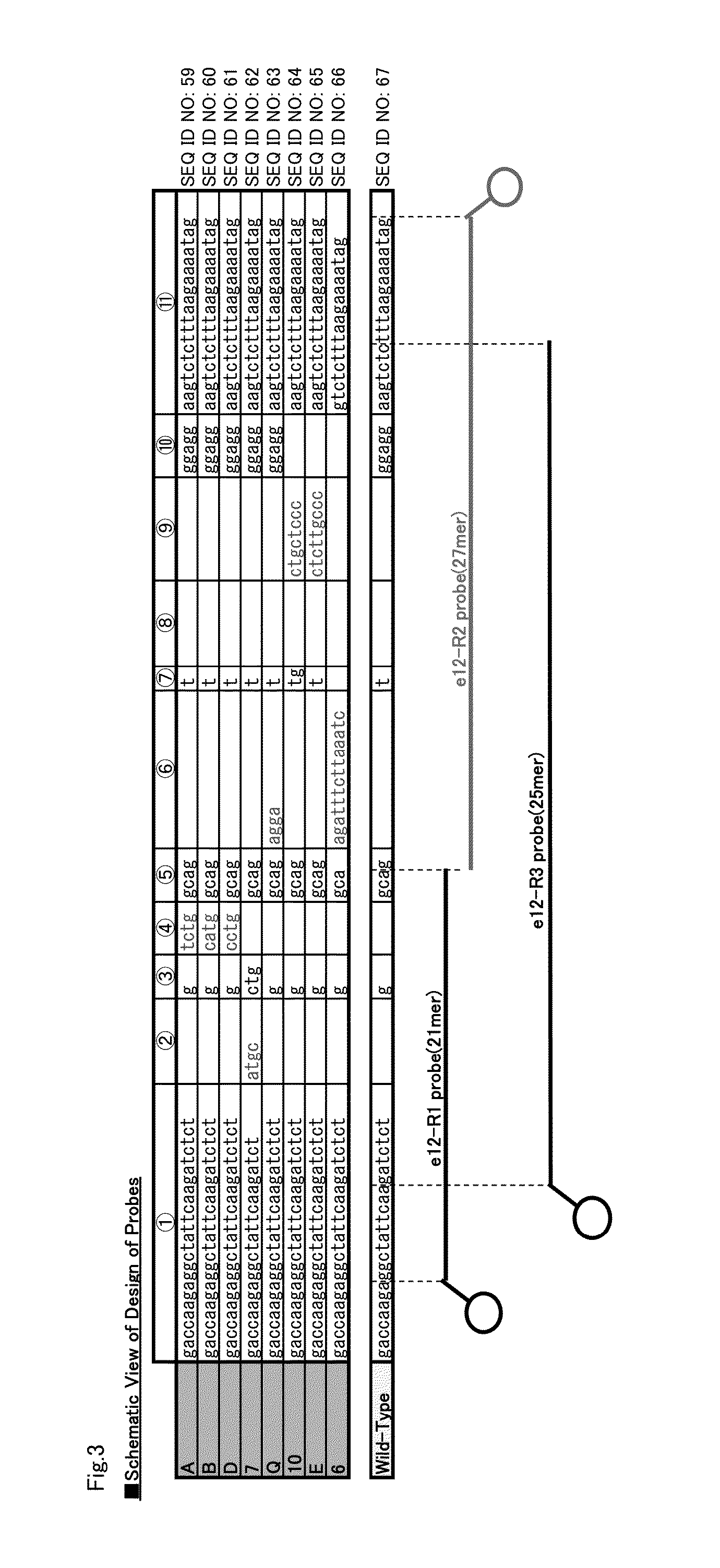Probe for detecting polymorphism in exon 12 of NPM1 gene and use thereof
a technology of npm1 and probe, which is applied in the field of probe for detecting polymorphism in exon 12 of npm1 gene, can solve the problems of difficult detection and inapplicability of methods to arbitrary sequences, and achieve the effect of eliminating the operation of recovery of an amplification product, high detection sensitivity and high specificity
- Summary
- Abstract
- Description
- Claims
- Application Information
AI Technical Summary
Benefits of technology
Problems solved by technology
Method used
Image
Examples
example 1
Detection from Complementary Strand Oligonucleotide Using Probes P1 and P2
[0164]Based on the nucleotide sequence of exon 12 of the NPM1 gene (SEQ ID NO:1 (wild type)), the probes having C at their ends shown in table 2 were designed. In table 2, the position of each probe is indicated by its nucleotides in the nucleotide sequence shown in SEQ ID NO:1. “P” at the 3′ end indicates phosphorylation. Labeling with TAMRA was carried out according to a conventional method.
[0165]The sequences of the complementary strand oligonucleotides used as the subjects of detection are shown in Table 2. In Table 2, the position of each oligonucleotide is indicated by its nucleotides in the nucleotide sequence shown in SEQ ID NO:1. In Table 2, bases represented by uppercase letters indicate the position of mutation which is characteristic to each mutation.
[0166]
TABLE 2SEQ ID NO:Probe nameSequence(5′→3′)PositionsMer43T-NPM1-e12-R1tgccagagatcttgaatagcc-(TAMRA)155-1352155T-NPM1-e12-R2(TAMRA)-ctattttcttaaag...
example 2
Detection from Blood Sample or Artificial Nucleic Acid Plasmid
[0188]In order to study whether detection by Tm analysis is possible after nucleic amplification, the reaction was performed using a blood sample. Further, in order to study how much proportion a mutation in exon 12 of the NPM1 gene should be contained in a sample to allow detection of the mutation, detection waveforms obtained with various mixing ratios between artificial nucleic acid plasmids of the wild-type sequence and a mutant sequence (Type A or Type E) were observed. As the artificial nucleic acids, plasmids were prepared by insertion of the wild-type sequence around exon 12 of the NPM1 gene (590 bp, SEQ ID NO:1), the mutant type A (594 bp, SEQ ID NO:2) or the mutant type E (594 bp, SEQ ID NO:3) to pUC plasmid vector.
[0189]The PCR and Tm analysis were carried out using a fully automatic SNPs testing device (trade name: i-densy IS-5310, manufactured by ARKRAY, Inc.). The conditions of the PCR and Tm analysis were a...
example 3
Detection from Complementary Strand Oligonucleotide using Probes P5, P6 and P7
[0207]As for exon 12 of the NPM1 gene, many mutated sequences are reported and most of them are Type A, Type B or Type D (See Table 1). Thus, the important factor of a probe for detecting exon 12 mutations in the NPM1 gene is the ability to detect Type A, Type B and Type D clearly.
[0208]Based on the nucleotide sequence of exon 12 of the NPM1 gene (SEQ ID NO:2 (Type A)), the probes having C at their ends shown in table 15 were designed. In table 15, the position of each probe is indicated by its nucleotide positions in the nucleotide sequence shown in SEQ ID NO:2. Labeling with PACIFIC BLUE, TAMRA and PODIPY FL was carried out according to a conventional method.
[0209]The reagent solution was the same with those used in Example 1 except that the following probes were used. Further, Tm analysis was carried out as in Example 1.
[0210]The sequences of the complementary strand oligonucleotides used as the subject...
PUM
| Property | Measurement | Unit |
|---|---|---|
| pH | aaaaa | aaaaa |
| temperature | aaaaa | aaaaa |
| melting temperature | aaaaa | aaaaa |
Abstract
Description
Claims
Application Information
 Login to View More
Login to View More - R&D
- Intellectual Property
- Life Sciences
- Materials
- Tech Scout
- Unparalleled Data Quality
- Higher Quality Content
- 60% Fewer Hallucinations
Browse by: Latest US Patents, China's latest patents, Technical Efficacy Thesaurus, Application Domain, Technology Topic, Popular Technical Reports.
© 2025 PatSnap. All rights reserved.Legal|Privacy policy|Modern Slavery Act Transparency Statement|Sitemap|About US| Contact US: help@patsnap.com



